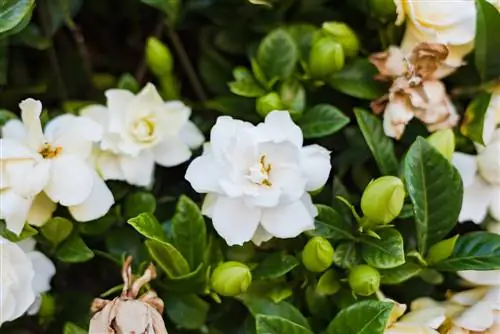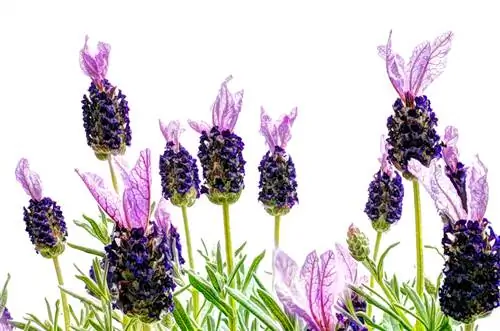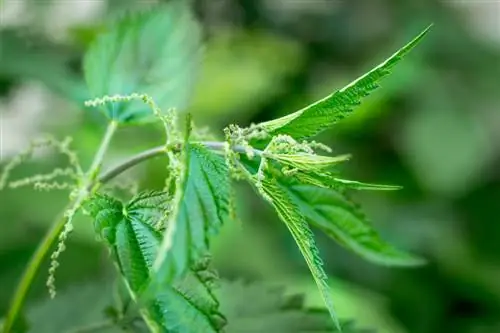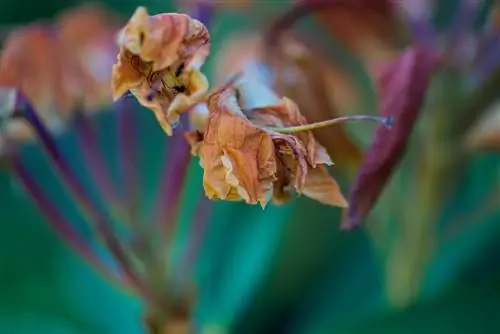- Author admin [email protected].
- Public 2023-12-16 16:46.
- Last modified 2025-06-01 06:02.
Read a commented profile of the gardenia as a potted plant here with information on scent, flowering time and winter hardiness. The best gardenia care tips for indoor gardeners, compact and comprehensible.
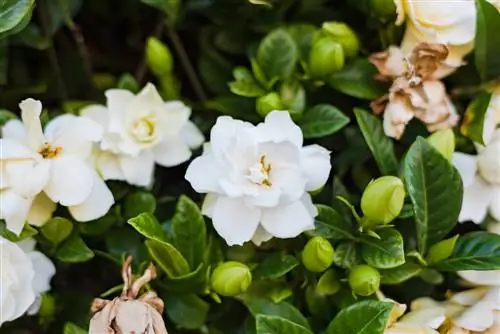
What should you know about caring for gardenias?
The gardenia (Gardenia jasminoides) is a tropical potted plant known for its white, cup-shaped and intensely fragrant flowers. It requires a bright but not full sun location, constantly high humidity and lime-free irrigation water. It is not hardy and slightly poisonous.
Profile
- Scientific name: Gardenia jasminoides
- Family: Rubiaceae (Rubiaceae)
- Synonyms: jasmine rose, boutonniere, flower gardenia
- Origin: Tropics
- Growth type: shrub, small shrub
- Flower: cup-shaped
- Flower color: white
- Flower characteristics: intense scent
- Flowering period: May to October
- Leaf: oval, evergreen
- Winter hardiness: not hardy
- Toxicity: slightly toxic
Bloom
Few houseplants can compete with the fairytale flower magic of a gardenia. The secret of the glamorous performance is the following combination of shape, color and scent:
- Fragrance: intense, sweet, buttery note, floral-powdery nuance
- Flower shape: cup-shaped, half or lushly filled
- Flower color: bright white, later creamy white to creamy yellow
- Flower size: up to 15 cm in diameter
- flower ecology: hermaphrodite
- Flowering time: May to October
The intoxicating scent of gardenia flowers inspires perfume manufacturers such as Chanel and Dior to create high-quality perfumes with gardenia as the heart note.
leaves
The evergreen, shiny leaves are a representative backdrop for the creamy white blossoms of a flower gardenia. When jasmine roses are not in bloom, the dark green leaves take over the decorative scepter. These attributes characterize the pretty foliage:
- Shape: elongated-oval
- Size: 6cm to 7cm long
- Arrangement: opposite
- Texture: leathery, shiny
For indoor gardeners, leaf color is an important characteristic. If the location is too cold, the dark green leaves turn yellow. Please pay particular attention to the following information on winter hardiness and temperatures.
Winter hardiness
Gardenia jasminoides is native to Southeast Asia. There is a warm, humid rainforest climate all year round with average temperatures between 21° and 25° Celsius, rising to 40° Celsius in March and April. Under these conditions, gardenias in our latitudes are not designed for life in the open air. The following table shows why jasmine roses are not hardy:
| Temperatures Gardenia | Degrees Celsius |
|---|---|
| Critical temperature minimum | 12° C |
| Average annual values | 17° to 24° C |
| Summer | 20° to 25° C |
| Winter | 14° to 17° C |
| Formation of buds | 16° to 18° C |
Growth
Gardenias are not flowers, but small shrubs. The evergreen leaves and white flowers grow on woody branches. In their tropical and subtropical home regions, the magnificent flowering trees are popular as hedge plants. As potted plants on a Central European windowsill, the exotic beauties remain significantly smaller. The following overview gives the details:
- Growth height in the area of origin: 80 cm to 160 cm
- Growth height as a potted plant in Central Europe: 20 cm to 60 cm
- Special feature: densely bushy, richly branched
Toxicity
All parts of a gardenia plant are slightly poisonous. The highest concentration of toxic ingredients is found in the orange berries. Flower gardenias are not recommended as potted plants for the family household. At the very least, the location should be out of the reach of children and pets.
Planting gardenia
Prologue for a gardenia in top shape is the right planting. The demanding tropical beauty values an appropriate planter, optimal substrate and a carefully selected location. The parameters are tight. After all, it is your horticultural decision whether you buy or propagate a gardenia. The following sections explain important details.
Propagate gardenia
Hobby gardeners with a penchant for challenges plant new gardenias for free. The green stroke of genius can be achieved by simply propagating Gardenia jasminoides. The following short instructions explain the procedure:
- Best time is in spring
- Cut cuttings without buds with a length of 5 cm to 7 cm
- Plant cuttings in moist coconut soil or pricking substrate
- Put a plastic bag over it or place it in a heated indoor greenhouse
- Keep moist in a bright location at a constant 25° Celsius and do not fertilize
Alternatively, you can root gardenia cuttings in water beforehand, as the following video demonstrates:
Video: Rooting gardenia cuttings in water
Repotting
With a height of around 20 centimeters, the breeding phase leads to evergreen adult life. Now you can repot the flower gardenia, as is also the case with a purchased specimen. You can read tips about the optimal planter and correct potting in the following sections:
Substrate
Gardenias prefer lime-free substrate with an acidic pH value of around 5. Commercially available azalea or rhododendron soil, enriched with coconut soil and lava granules for best permeability, are well suited.
Preparing the planter - potting the Gardenia plant
A purchased or propagated gardenia must not remain in the nursery pot. As a planter, choose a pot with holes in the bottom for drainage. Measure the pot size so that one or two fingers fit between the root ball and the container wall. How to plant a jasmine rose in an exemplary manner:
- Cover the bottom of the pot with expanded clay, lava granules or clay shards as drainage
- Pour a handful of substrate
- Plant root balls with a 2 cm to 3 cm high watering edge
- Press down the soil and water thoroughly
Fill the pot coaster with pebbles, expanded clay or lava granules. This trick prevents waterlogging from forming when excess irrigation water accumulates. Furthermore, water evaporation creates locally increased humidity, which your gardenia is very comfortable with.
Location
When choosing a location, important parameters relating to light and temperature conditions must be taken into account:
- Bright to sunny location without blazing sun in the afternoon.
- Ideally on the west or east side.
- In the location on the south windowsill with shade from midday or behind a transparent curtain.
- High humidity of over 60%.
The table above in the commented Gardenia profile provides a detailed overview of the correct temperatures.
Excursus
Scented accessory for gentlemen
The man of the world wears a buttonhole flower on celebratory occasions. The best choice for an elegant appearance during the day is the opulent, white blossom of a gardenia. The fragrant accessory can be attached in style in the buttonhole on the left side of the lapel. As a colorful counterpart for the representative evening wear, the gentleman chooses the red carnation 'Burning Love' (Lychnis chalcedonica) as his buttonhole flower.
Gardenia care instructions
Gardenias are beautiful but difficult to care for. With these care instructions and a little tact, you can master the demanding task with flying colors. The effort is worth it for one of the most beautiful houseplants with white flowers. Don't miss these tried-and-tested tips on perfect gardenia care:
Pouring
A gardenia does not tolerate drought stress or waterlogging. How to water the buttonhole flower correctly:
- Rule of thumb: Gardenia are watered evenly as soon as the surface is noticeably dry.
- Water quality: The irrigation water must be almost lime-free, ideally rainwater or softened tap water.
- Spray the leaves: Before the flowering period begins, spray the leaves with room temperature, soft water.
Once buds form, you should stop spraying a gardenia. Water splashes on buds and flowers cause rot and brown spots. To ensure consistently high humidity, place a humidifier near plants. If you haven't already done so when planting, fill the saucer with expanded clay and water now.
Fertilize
The furious blossoms come with a high nutrient requirement. Fertilize your gardenia with liquid rhododendron or azalea fertilizer every two weeks from March to September. Please water before and after with clear water to ensure loss-free nutrient absorption.
Wintering
Unlike most potted plants, gardenias do not take a long winter break. Slight modifications in care will keep the evergreen shrubs he althy and happy through the cold season. This is how you properly overwinter your houseplants:
- Overwinter Gardenia in its usual location.
- After the flowering period, water more sparingly without letting the root ball dry out.
- Fertilize without lime every six to eight weeks from October to February.
Cutting
Moderate pruning in early spring creates a beautiful, compact shape. The best cutting tool is a pair of bypass scissors (€9.00 on Amazon), whose sharp blades leave smooth cuts. For a competent cut, place the scissors a few millimeters above an outward-facing eye.
Repotting
Every two years the root ball in the planter becomes too tight. Furthermore, the substrate is leached and should be replaced. A gardenia is repotted in spring, shortly before the buds form.
Pests
Gardenias weakened by location problems or care errors are susceptible to lice. Check the potted plant regularly for aphids and scale insects. Lack of light and dry heating air cause spider mites to appear in winter. An effective home remedy against these pests is the classic soap solution, which you can make yourself or buy ready-made.
Popular varieties
These gardenia varieties live up to the accolade of 'most beautiful houseplant with white flowers':
- Gardenia rich sense: Magnificent variety from the Dutch Rich Sense product line with a quality guarantee.
- Magnifica: impresses with dark green, shiny decorative leaves, does not bloom so profusely.
- Radicans: Dwarf variety with smaller flowers and leaves, ideal as a pot plant.
- Gardenia Exotenherz: compact houseplant with creamy white flowers and a seductive scent.
- African Forest Gardenia: Rarity from South Africa with 8 cm large flowers and 2.5 m height.
Behind the trade names 'Crepe Gardenia' or 'Butterfly Gardenia' there is a new variety with white, curled scented flowers and evergreen leaves. Strictly speaking, it is a shrub from the dogpoison family called Tabernaemontana divaricata with a height of 150 centimeters, which also flowers in the shade.
FAQ
Are gardenias hardy?
No, gardenias do not tolerate frost. If the temperatures at the location fall below 12° Celsius, the tropical flower gardenia is doomed. Typical symptoms include dropping of buds and flowers as well as yellow-brown leaf discoloration. Only in very mild wine-growing regions can a jasmine rose stay on the balcony or terrace in summer.
My gardenia has yellow leaves. What to do?
If the dark green leaves turn yellow, location problems and care errors are possible triggers. The main cause is temperatures below the critical mark of 12° Celsius. In this case, moving to a warm place will solve the problem. If the root ball is waterlogged, the leaves also turn yellow. By repotting the affected gardenia immediately, you will stop the fatal process. The third cause of leaf discoloration is calcareous irrigation water. Gardenias are always watered with rainwater or lime-free tap water.
Are gardenias flowers?
No, gardenias are not flowers in the sense of flowering, herbaceous plants. Gardenia jasminoides is actually an evergreen shrub. In its tropical and subtropical habitats, the jasmine rose can reach impressive heights. As a houseplant, the exotic flowering tree remains at a compact height of between 20 cm and 60 cm.

